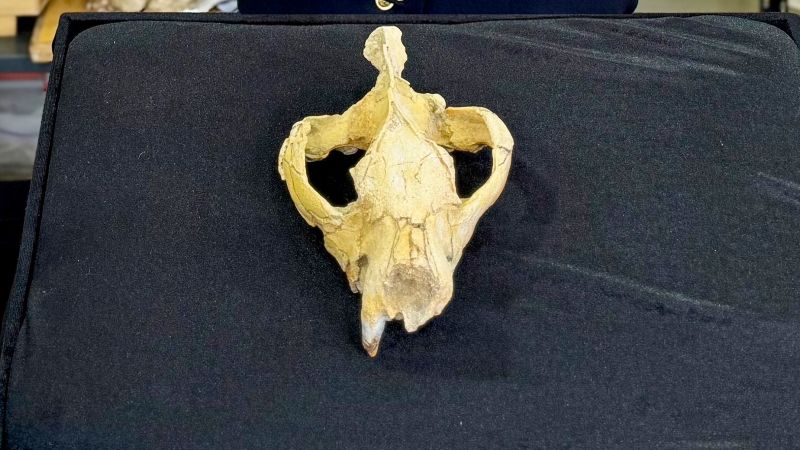
Subscribe to CNN’s Wonder Theory science newsletter.Dive into the cosmos with updates on intriguing discoveries, scientific breakthroughs, and more.
CNN
—
Hyaenodonts, ancient carnivorous mammals with sharp, feline-like teeth and a canine-like physique, once dominated their ecosystems as apex predators. However, this formidable lineage became extinct approximately 25 million years ago, leaving researchers puzzled as to what led to their demise.
Recently, a collaborative effort among paleontologists worldwide has unveiled a significant discovery — a nearly intact skull representing a previously unknown hyaenodont species. This find marks a vital advancement in understanding these ancient creatures and their evolutionary journey.
Unearthed in Egypt’s Fayum Depression, this fossil is the most complete skull from the hyaenodonta subfamily Hyainailourinae ever discovered in Africa. This skull dates back to the early Oligocene Epoch, roughly 30 million years ago, as documented in a recent publication in the Journal of Vertebrate Paleontology.
The skull was discovered in 2020 during an excavation, and lead author Shorouq Al-Ashqar, a Ph.D. candidate at Mansoura University Vertebrate Paleontology Center and research assistant at the American University in Cairo, recalls the excitement of the moment when they realized the rarity of their find.
“It was a breathtaking moment,” Ashqar shared. “This skull holds immense value not only because it is complete and three-dimensional, but also due to the new features it reveals about this extinct group of carnivorous mammals.”
The researchers designated this leopard-sized species as Bastetodon syrtos, paying homage to the ancient Egyptian deity Bastet based on its shorter snout when compared to other hyaenodonts. This characteristic, coupled with its sharp, knife-like teeth, would have equipped the creature with a formidable bite, as noted by Ashqar.
“We can certainly say that Bastetodon was the ruler of the ancient Egyptian forests,” declared Ashqar.
This remarkable fossil provides a rare view into an era characterized by significant global environmental shifts and faunal turnovers, during which various species faced extinction while new ones emerged in response to ecological modifications. These transformations were essential in shaping the modern cat and dog predators we observe today, according to researchers.
Fossils of hyaenodonts have been discovered across North America, Europe, Asia, and Africa. These creatures varied greatly in size, with some comparable to rhinoceroses while others resembled petite weasels.
During the Oligocene epoch, the Fayum Depression was a vibrant, tropical rainforest ecosystem. The predatory Bastetodon would have hunted primates like Aegyptopithecus, an ancient ancestor of humans, along with early hippos and elephants.

“I envision them as powerful versions of wolverines, or akin to pitbulls with robust heads covered in muscle,” commented Dr. Matthew Borths, a coauthor of the study and curator of fossils at the Duke Lemur Center Museum of Natural History at Duke University in Durham, North Carolina.
Finding fossils of ancient carnivores is uncommon because these predators are less numerous in ecosystems compared to herbivores (for example, you are more likely to spot a deer or a squirrel than a cougar while hiking, as Borths pointed out). Typically, only teeth or skull fragments are recovered, he added.
The discovery of such a well-preserved skull enables researchers to investigate specific traits of the animal, including the size of muscle attachments relative to its teeth, the volume of its brain, and even the strength of its sense of smell, Borths noted.
Researchers also drew comparisons between the Bastetodon skull and the fossils of a larger hyaenodonta species discovered in Africa around 120 years ago. This species, named Sekhmetops by the study team, was initially believed to be linked to a European group of hyaenodonts. Despite having only jaws and cheekbones recovered, researchers used the findings from these remains to show that Bastetodon and Sekhmetops belonged to the same lineage of hyaenodonts originating from Africa.
“It is quite rare to encounter such a complete specimen that showcases not only strong teeth but also intricate details of cranial structure,” remarked Dr. Nancy Stevens, an anthropology professor and director of the Museum of Natural History at the University of Colorado Boulder, via email.
“Only through an in-depth analysis of specimens like this can we investigate the complex movement behaviors of predators within historical landscapes,” added Stevens, who did not participate in the study. “This enhances our understanding of contemporary faunal dynamics.”
The Eocene-Oligocene boundary denotes a significant global cooling event that transpired approximately 34 million years ago, leading to mass extinctions and substantial shifts in species. The hyaenodonts that persevered during this period displayed remarkable adaptability and resilience, according to Borths.
However, a few million years later, these creatures faced extinction, ultimately being outcompeted by the ancestors of modern dogs, cats, and hyenas. By filling the gaps in the fossil record, paleontologists seek to comprehend the factors that contributed to the hyaenodonts’ extinction, as well as how much environmental adaptation pressures a lineage can withstand, Borths elaborated.
“The extinction of the Hyaenodonta during the late Oligocene illustrates the impact of climate change, competitive dynamics, and shifts in prey availability on carnivorous species,” stated Dr. Cathrin Pfaff, a postdoctoral researcher and lecturer at the Institute of Palaeontology at the University of Vienna, Austria. She was not involved in the current research.
“The reasons they were outperformed by cats and dogs throughout evolution remain unclear, but it could relate to their specialized teeth structure,” Pfaff noted in an email. “Given this, discoveries like the one described here represent a crucial step toward unraveling this mystery, even if this specimen is of medium size.”










